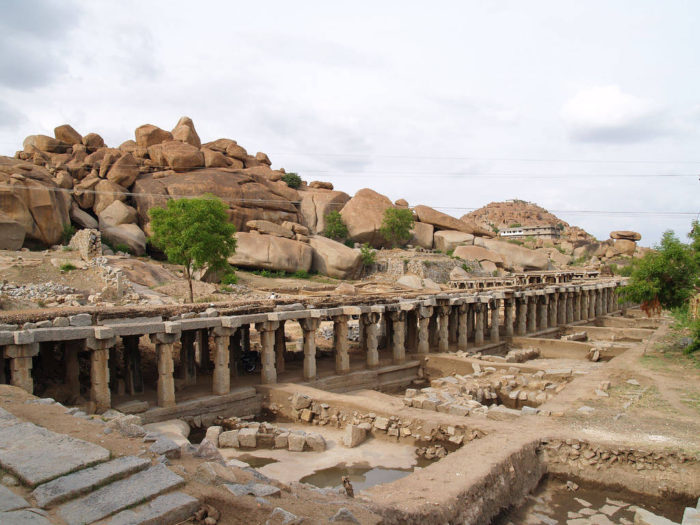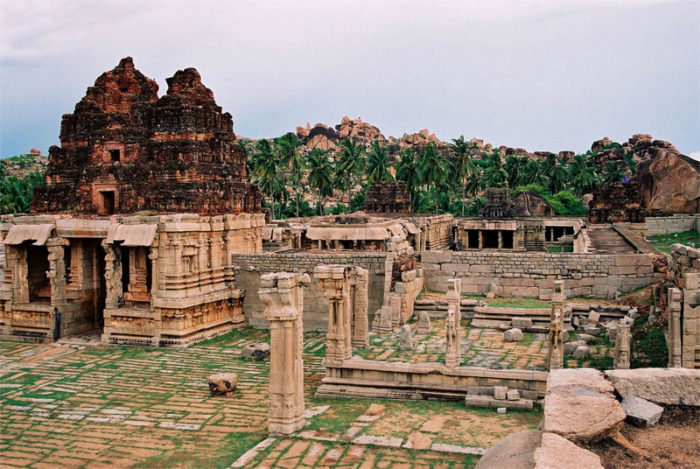Hampi The Capital Of the Vijayanagara Dynasty
Hampi, The Capital of the Vijayanagara Dynasty:
Hampi was the capital city of the Vijayanagara Empire during the 14th – 16th century CE. It was the last Hindu kingdom in India. The city is located on the banks of the Tungabhadra basin in central Karnataka, Bellary District.

Hampi is a spectacular place with the beautiful flow of the Tungabhadra river and is enclosed with hill ranges. The greenery plains spread widely and give a lot of attraction to the city. The city thrived for nearly 250 years. Many monuments here still indicate the past glory of the capital. The complexes, Shrines, Royal Palaces, Forts and many others remain to narrate the treasure of Hampi to the visitors.
Legends about Hampi:
Hampi is situated on the banks of the Tungabhadra river. There is a story behind the formation of Hampi city. One day the brothers Harihara Rayalu and Bukkarayalu went to the forest to hunt with the prey dogs. The dogs saw the Rabbits and ran towards them to catch them; at once, the Rabbits started defying the dogs. The brothers looked at the sudden incident and were astonished after looking at the bravery of the Rabbits. Returning to their kingdom, they narrated the peculiar incident to their Guru, Vidhya Ranya Swami.
Then the Sage went to the place and analyzed and found out the importance and power of the site. Then he guided his disciples Harihara and Bukka Raya to build a city, made it their capital, and ruled from there. With his blessings, the brothers built a town called Hampi and made it the capital of the Vijayanagara Empire.
The glory of Hampi:
The famous Krishna temple complex is the religious place where we can see the group of temples of Ganesh, Hemakata and Narishma Gods. The architecture of the temples shows us the ancient techniques and skills of the Vijayanagara people. The defence architecture, the residential areas, and the Shrines offer us how Hampi became the most beautiful city in the world. Here the people’s economic prosperity and political states show us the highly developed society. The Vijayanagara emperors encouraged Dravidian architecture, and the Dravidian construction constructed every corner of the Hampi. Here the decorative pillars, lofty towers and cloistered enclosures are still beautiful and astonish the visitors with their beautiful structures.
Vittala Temple:

Here the Vittala temple is the most famous temple with a rich structure. The temple’s ornate structures represent the culmination of Vijayanagara temple architecture—the place combined with Kalyana Mandapam and Utsava mandapam. The temple has three entrance Gopurams. Here the grand bazaar street and a granite ratha are the famous places to visit and know how Hampi left its presence in history with unbelievable monuments.
The Chariot street is famous, wide and flanked by rows of pillared Mandapas.
The emperors celebrate Chariot Festivals on these streets with great pompousness. So the granite chariot was made as a sculpture of a single piece of granite before the temple. Here the statues are made of the local granite, brick and local mortar used for other constructions. The temple entrance gopuras and the Sanctum are constructed with stone and brick. The roofs of the temple lay with heavy thick granite slabs. Those granite slabs are covered with brick jelly and lime mortar.
The architecture of Hampi Monuments:
Here the architecture of all the constructions are built-ins of Indo-Islaarchitecture elements actual. Queen’s bath and elephant stables evolved into a multi-religious and multi-ethnic society. In Hampi, the structure of the building continued for over 200 years. The style of the monuments shows us the religious and political scenario and the advancements in art and architecture. But unfortunately, the glory of Hampi ended with the battle of Talikota. After the Talikota battle, the Muslim invaders demolished the entire city of Hampi.
One thought on “Hampi The Capital Of the Vijayanagara Dynasty”